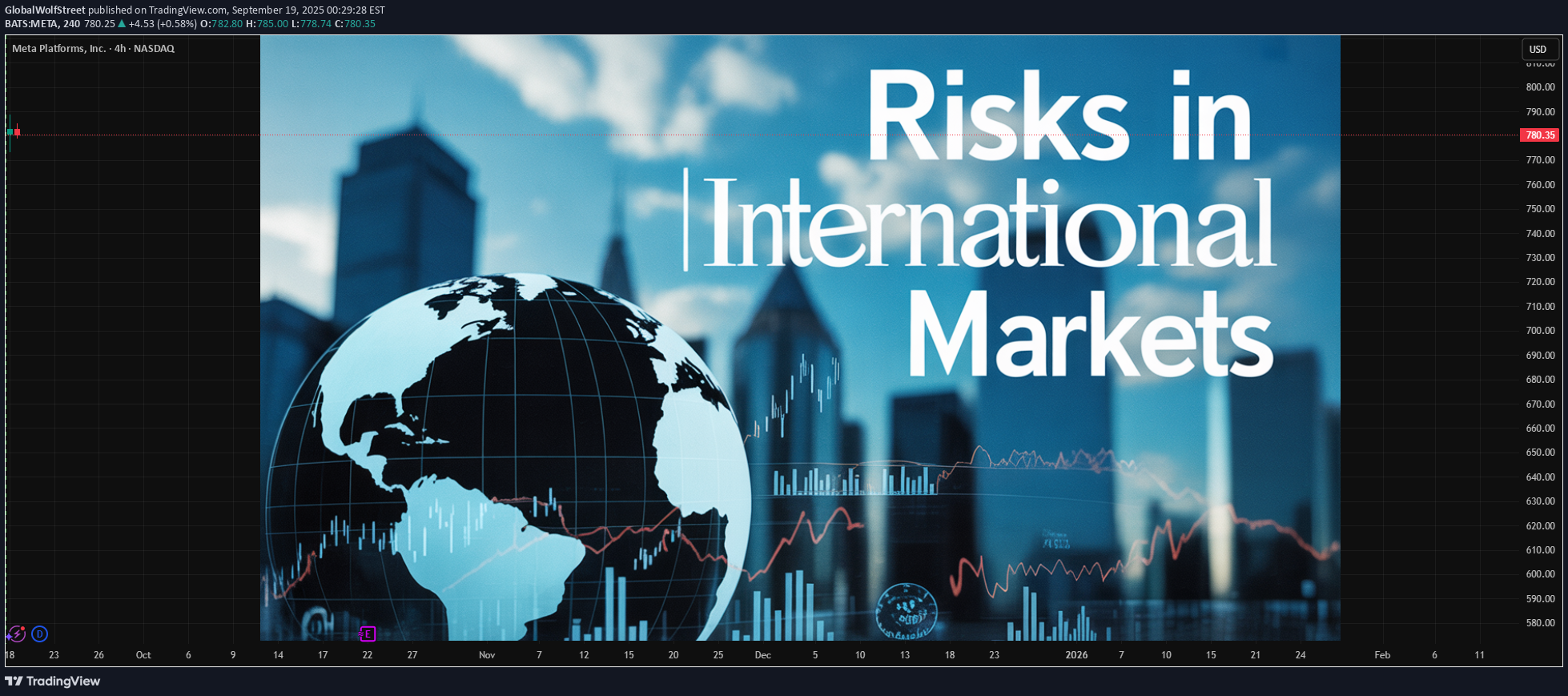تحلیل تکنیکال GlobalWolfStreet درباره نماد METAX در تاریخ ۱۴۰۴/۶/۲۸

1. Understanding Risk in International Markets Risk in international markets refers to the uncertainty of outcomes when engaging in cross-border transactions, investments, or trade. These risks can impact profitability, growth, and sustainability. For example: A company exporting goods to another country may face currency exchange fluctuations that erode profit margins. A multinational corporation (MNC) investing in a politically unstable country may face expropriation or asset seizure. A sudden tariff imposition or trade sanction could disrupt supply chains. International risks are interconnected. An economic crisis in one country can trigger contagion effects worldwide. Thus, risk management in global markets requires a broad, multi-dimensional approach. 2. Categories of Risks in International Markets International risks can be broadly classified into the following categories: 2.1 Political Risk Political risk arises when government policies, political instability, or conflicts impact international trade and investment. Examples: Nationalization of assets, sudden changes in trade regulations, wars, or regime changes. Case Study: In 2014, many Western firms in Russia faced difficulties after sanctions and retaliatory measures disrupted business operations. Subtypes: Expropriation risk (government seizing foreign assets). Political violence (civil war, terrorism, coups). Regulatory changes (new trade barriers, taxes, or restrictions). 2.2 Economic and Financial Risk Economic risk involves the uncertainty of operating in economies with unstable macroeconomic conditions. Examples: Inflation, recession, unemployment, or sovereign debt crises. Currency risk (Exchange Rate Volatility): A major component where fluctuating exchange rates can reduce profits. Case Study: The Asian Financial Crisis (1997) saw many businesses collapse due to currency devaluation. Subtypes: Inflation risk Interest rate risk Liquidity risk Balance of payments crisis 2.3 Currency and Exchange Rate Risk Exchange rate fluctuations are one of the most common risks in global trade. When a company exports goods, a sudden fall in the buyer’s currency reduces earnings when converted to the seller’s currency. Importers face higher costs when their domestic currency depreciates. Case Study: Indian IT companies billing in US dollars benefit from a stronger dollar, but importers of oil in India face higher costs when the rupee depreciates. 2.4 Legal and Regulatory Risk International markets operate under diverse legal systems. A company must comply with multiple laws, including labor, taxation, intellectual property rights (IPR), and environmental regulations. Examples: A pharmaceutical company selling in Europe must comply with strict EU health and safety standards. Data protection laws like GDPR affect global tech firms. Failure to comply can lead to penalties, lawsuits, or bans. 2.5 Cultural and Social Risk Culture impacts consumer behavior, workplace practices, and negotiations. Misunderstanding cultural norms can damage a company’s brand image. Examples: Marketing blunders due to mistranslation of slogans. Fast-food chains adapting menus to local tastes (e.g., McDonald’s in India does not serve beef). Cultural risks also affect labor relations, communication styles, and management practices. 2.6 Supply Chain and Operational Risk In global trade, companies rely on complex supply chains. Disruptions at any point can impact operations worldwide. Examples: Natural disasters halting production. Port strikes delaying shipments. Shortages of raw materials. Case Study: The COVID-19 pandemic disrupted global supply chains, causing shortages in semiconductors, medicines, and shipping delays. 2.7 Geopolitical and Security Risk Tensions between countries can lead to sanctions, embargoes, or outright bans. Security risks such as terrorism, piracy, and cyber-attacks further complicate global trade. Examples: The US-China trade war caused tariffs and uncertainty in global supply chains. Cyber-attacks on financial institutions threaten international capital flows. 2.8 Environmental and Sustainability Risk Global businesses must consider environmental regulations, climate risks, and sustainability demands. Examples: Stricter carbon emission rules affecting manufacturing firms. Climate change threatening agriculture and insurance industries. Case Study: European Union’s Carbon Border Adjustment Mechanism (CBAM) impacts exporters from developing nations by imposing carbon tariffs. 2.9 Technological Risk Technology drives global trade but also creates risks: Cybersecurity threats. Dependence on foreign technology providers. Rapid technological obsolescence. Example: Semiconductor shortages exposed the vulnerability of global industries dependent on a handful of suppliers. 2.10 Reputational Risk A company’s reputation is global. A scandal in one country can affect its worldwide image. Case Study: Volkswagen’s “Dieselgate” emissions scandal damaged its global reputation, leading to billions in losses. 3. Real-World Examples of International Market Risks Brexit (2016–2020): Created uncertainty for businesses trading between the UK and EU, leading to tariffs, regulatory complications, and currency volatility. COVID-19 Pandemic (2020–2022): A global supply chain crisis, demand shocks, and international border restrictions. Russia-Ukraine War (2022 onwards): Caused oil price volatility, sanctions, and food supply disruptions. US-China Trade War: Tariff escalations disrupted supply chains, affecting electronics, steel, and agriculture. 4. Impact of Risks on International Business Profitability: Exchange rate swings and tariffs can reduce profit margins. Market Entry Barriers: Political instability or protectionist policies deter investments. Supply Chain Vulnerabilities: Disruptions increase operational costs. Investor Confidence: Economic instability reduces foreign direct investment (FDI). Strategic Shifts: Companies diversify operations to reduce overdependence on one country. 5. Strategies to Manage International Market Risks 5.1 Hedging and Financial Instruments Use of derivatives like futures, options, and swaps to manage currency and interest rate risks. Example: Exporters hedge against exchange rate volatility by locking in forward contracts. 5.2 Diversification Geographic diversification reduces dependence on one market. Supply chain diversification reduces risk from disruptions in one region. 5.3 Insurance Political risk insurance protects companies against expropriation, terrorism, or war. Trade credit insurance covers non-payment by foreign buyers. 5.4 Strong Legal Compliance Understanding and complying with local laws reduces regulatory risk. Companies often hire local legal experts. 5.5 Cultural Adaptation Training employees in cross-cultural management. Localizing products and marketing strategies. 5.6 Scenario Planning and Risk Assessment Conducting “what-if” analyses to prepare for potential disruptions. Example: Airlines hedge fuel costs against oil price fluctuations. 5.7 Building Resilient Supply Chains Developing multiple suppliers. Using digital technologies (AI, blockchain) for supply chain transparency. 5.8 Sustainability and ESG Practices Adopting environmentally responsible strategies reduces reputational and regulatory risks. Attracts socially conscious investors. 6. The Future of Risk in International Markets Global risks are evolving rapidly: Climate change will intensify natural disasters and regulatory pressures. Technological risks will grow with AI, automation, and cybersecurity challenges. Geopolitical rivalries (US-China, Russia-West) will increase uncertainty. Global financial risks like debt crises and inflationary pressures may spread faster due to interconnected economies. Companies of the future must adopt resilient, adaptive, and technology-driven risk management frameworks. Conclusion International markets present unparalleled opportunities, but they are inherently riskier than domestic markets. Risks in the international market stem from politics, economics, culture, law, technology, environment, and global interconnectedness. Businesses that succeed in global markets are not those that avoid risks entirely but those that anticipate, assess, and strategically manage risks. From hedging financial exposures to diversifying supply chains, from complying with local laws to embracing sustainability, risk management is the backbone of international business success. As the global economy grows more complex, the key will be resilience: the ability to withstand shocks, adapt to new realities, and continue to thrive despite uncertainty.
